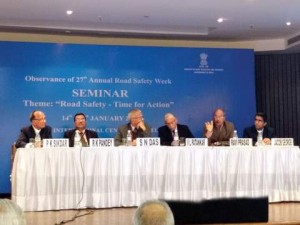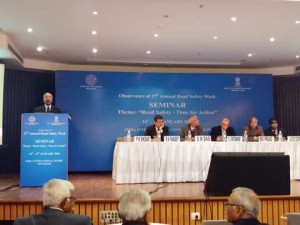The Ministry of Road Transport and Highways and the International Road Federation highlighted the need for road safety.
Story and photographs: Gaurav Nagpal
The Ministry of Road Transport and Highways (MoRTH) and the International Road Federation (IRF) organised a seminar on road safety in Delhi as part of the road safety week recently. The seminar delved upon the aspects of road safety, the nature of problem and the possible solutions. Drawing attention to statistics that put the annual death toll count to 138,000, which is 10 per cent of the global road accident deaths, KK Kapila, Chairman, IRF, in his keynote address revealed that 50 million Indians live with injuries as a result of road accidents. The total estimated loss is over Rs. 200,000 crores with the situation especially worrisome for low- and middle-income countries, he mentioned. Emerging economies that are fast urbanising seem to be at a greater risk. With safer road and mobility as one of the five pillars of the UN Global Plan for the Decade of Action for Road Safety 2011-2020, all the nations of the world have resolved to work together to reduce accidents and fatalities by 50 per cent by the end of 2020.
Stressing on a need for a concerted effort, the panelists, discussed about black spots. Defining black spot as a section of road up to 500 m length or a junction witnessing repetitive road accidents over a period of two to three years, the panelists drew attention to the identification of 726 blackspots by MoRTH. The reason for creation of blacks spots was attributed to hasty preparation of detailed project reports (DPRs) due to competitive pressures, exclusion of safety features from DPRs, and cost and time overruns during actual execution. Also, factors like poor facilities for pedestrians on high-speed roads, incorrectly-located median openings, hazardously-designed slip roads, uncontrolled access from village roads to major highways, and poor road maintenance. IRF, mentioned one panelist, is working on 10 worst spots with more than 200 accidents in 2014.
Apart from the need for regular and stringent road safety audits (RSAs), which have been completed for 9,835 kms, with 7,156 observations made (of which 4,988 have been implemented), the panelists discussed upon the process of removal of black spots like identifying the location from accident data, analysing data to understand the nature and causes of accidents and the most affected user groups, site visits for assessment from a driver’s perspective, designing counter measures (to be redesigned if needed based on feedback) and implementing the same, and monitoring and evaluating the improved location. While one panelist stated that the MoRTH has sanctioned an investment of Rs. 11,000 crore on road safety, with relevant measures incorporated into road construction contracts and RSAs made mandatory at all stages, Ravi Prasad, Chief Engineer, MoRTH, revealed that the Indian Academy of Highway Engineers (IAHE) has proposed the development of a six-week course for RSAs designed in association with IRF. The course and details would be announced shortly, he mentioned.
During the discussion on road safety education, the panelists delved upon road safety being woven into many subjects in the syllabus of the National Council of Educational Research and Training (NCERT) for classes 6-10. Rajasthan has implemented the same revealed one panelist. He pointed out that the World Bank (WB) is also using this curriculum in countries where it has provided funds for education. The dicussion on trauma care brought forth the fact that IRF has begun training heavy vehicles drivers on first aid trauma care by establishing the International Collaborative Centre for Mitigation of Adverse Outcomes from Traffic Incidents (ICMOT).
Stressing upon the need for effective enforcement of measures identified through RSAs, for which adequate funds are required, the panelists drew attention to MoRTH providing 10 per cent of the annual road safety budget, which is time-bound. Attention was also drawn to Multilateral Development Banks (MDBs) providing 10 per cent of the project cost towards road safety works. The panel delved upon the thought that when ‘x’ length of roads are sanctioned, ‘3x’ length worth of retrofitting of road safety measures should be also sanctioned. IPF’s promotion of use of IteS-based vehicle registration and licensing was highlighted. It was suggested that CSR funds can also be used for road safety, with a minimum exemption of 50 per cent under Section 80(G).





















